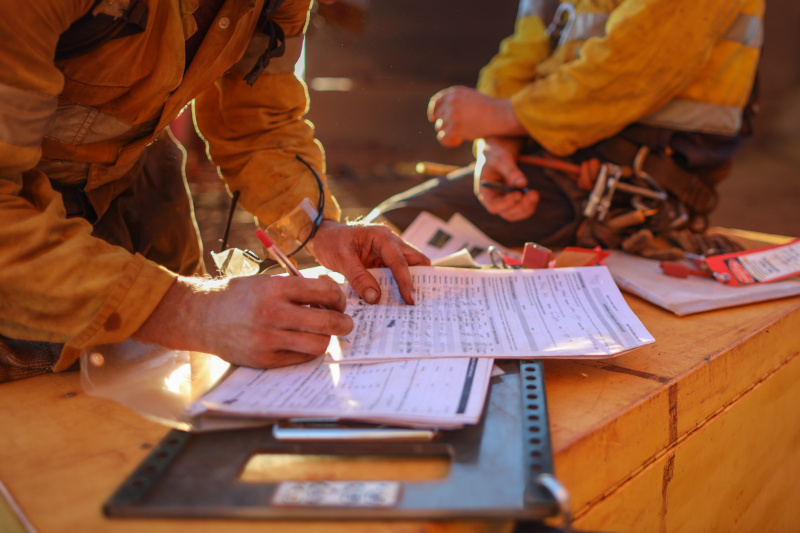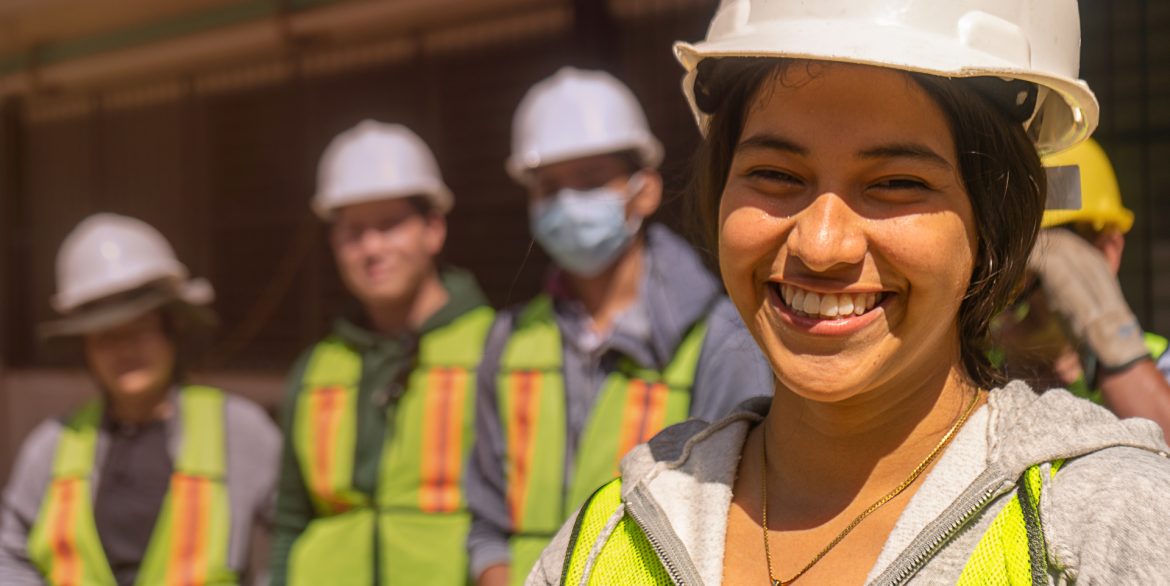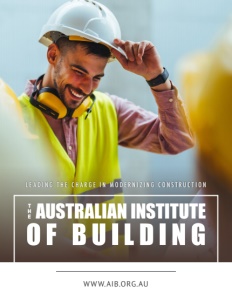The Australian Institute of Building (AIB)
Leading the Charge in Modernizing Construction
Building a great future for its valued members
Established in 1951, the Australian Institute of Building (AIB) is a key institution in the construction industry, renowned for its longstanding history and contributions. Awarded a Royal Charter in 1969, the AIB has grown to become the only industry body with members recognized as qualified and experienced constructors of any type. Today, the institute proudly serves over 4,000 members, predominantly commercial builders, who uphold the esteemed title of Chartered Builder. The vision of the AIB is clear: to be recognized as a progressive and inclusive organization that celebrates diversity and building excellence.
Evolving mission
Over the past few years, the AIB has undergone significant changes under the leadership of Executive Director Jeff Dart. When Dart joined the organization, one of his primary goals was to modernize the Institute and ensure its relevance in the contemporary construction landscape. “The last four years, when I came on board, we had to be progressive and inclusive because the association was stuck in the past,” Dart explains. His efforts have focused on making the AIB more relevant and inclusive, ensuring that it meets the needs of a modern and diverse workforce.
The AIB initiated several progressive programs to address these challenges, including the Girls in Construction initiative. The program targets senior secondary school girls, encouraging them to pursue careers in the construction industry. “One of our problems in the industry is we don’t have enough women to be successful,” Dart emphasizes. The Girls in Construction program includes a five-day camp where participants build a shed, providing hands-on experience and fostering an early interest in construction careers. The initiative has garnered support from Australian federal and state governments, reflecting a broader commitment to increasing female participation in the industry.
Membership growth and diversity
The AIB’s membership structure is diverse, accommodating different experience levels and expertise. From fellows with over a decade of industry experience to student members who are just beginning their construction careers, the AIB ensures a broad membership base. The institute has seen a net increase of 5-6% in membership over the past four years, reflecting its successful efforts to attract and retain younger members while acknowledging the retirement of older members.
Communication with members is a key priority for the AIB. The institute disseminates a monthly newsletter and a daily industry update, informing members about project developments, regulatory decisions, and other pertinent industry news. Additionally, the AIB hosts the Professional Excellence in Building Awards, an annual event celebrating outstanding construction achievements across Australia and Hong Kong. The awards highlight the technical and managerial excellence required to deliver high-quality projects, with state winners progressing to compete nationally.

Accreditation and advocacy
The AIB’s role as the arbiter of knowledge and learning in the construction industry is highlighted by its accreditation of 16 universities in Australia and one in New Zealand. The accreditations ensure that construction management degrees meet the evolving needs of the marketplace. “We make sure that the marketplace’s needs are reflected in the degrees that the universities are done,” Dart explains. This rigorous accreditation process helps maintain high standards in construction education and prepares graduates to meet industry demands.
Advocacy is another critical aspect of the AIB’s mission. Dart features the institute’s efforts to address the industry’s pricing challenges. “We’re advocating at the moment for the price of buildings to increase by 10 percent because Australian buildings are amongst the cheapest in the world of comparative cities,” Dart states.
The AIB argues that builders cannot invest in sustainable practices or accommodate the green movement’s demands without adequate margins. With the construction industry responsible for 38% of Australia’s carbon emissions, the AIB collaborates with other industry bodies through the Australian Construction Industry Forum to push for necessary changes and improvements.
Strategic partnerships
The AIB maintains strong relationships with key industry bodies, including Master Builders Australia, the Institute of Quantity Surveyors, and the Institute of Architects. These partnerships enable the AIB to leverage collective expertise and advocate for industry-wide improvements. The AIB also works closely with the National Association for Women in Construction to promote gender diversity and inclusion.
Dart envisions a promising future for the AIB and the construction industry. “The next five years looks quite promising in terms of projects planned,” Dart notes. With one and a half million migrants expected to arrive in Australia over the next five years, the demand for construction projects, particularly in housing and infrastructure, is set to increase.
Dart stresses the need for significant infrastructure investment to accommodate population growth. “We’ve had consecutive governments that haven’t invested enough in infrastructure like our transport system, for instance,” he said. The AIB advocates for enhanced investment in roads, hospitals, and other critical infrastructure to support the nation’s growth.
Addressing housing shortages
Australia’s housing shortage is a pressing issue that the AIB is actively addressing. The institute is working with the government to accelerate apartment construction and promote the Build to Rent model, which has seen significant success in the United States. “We need more accommodation for the stock, particularly apartments, and the absorption of the migrants,” Dart explains. The AIB aims to create sustainable living environments for Australia’s growing population by prioritizing infrastructure and housing projects.
Innovation and technology are also high on the AIB’s agenda. The institute is pushing to adopt advanced construction software and Building Information Management (BIM) systems. “The construction industry and the universities would agree that it’s backward in its embracement of technology, new processes, new systems, prefabrication,” Dart observes. The AIB’s focus on building excellence extends to promoting the latest technological advancements and improving construction practices across the industry.
Educational outreach
The AIB’s dedication to education is exemplified by its robust accreditation program and ongoing efforts to engage students and young professionals. The institute offers free first-year memberships to students, encouraging early involvement in the construction industry. “We’ve got about 700 students as members, and we see this as a vital part of our strategy to ensure the industry’s future,” Dart notes. The initiative helps students gain valuable industry insights and fosters a sense of community and belonging within the AIB.
In addition to student memberships, the AIB is exploring partnerships with secondary schools to introduce construction-related programs. “We’re developing programs with two girls’ schools in Sydney and two in Melbourne,” Dart shares. The programs aim to provide students with hands-on construction experience and inspire them to consider careers in the industry. By engaging students early, the AIB hopes to cultivate a new generation of skilled professionals passionate about building and construction.
Girls in Construction
The AIB’s efforts to promote diversity and inclusion extend beyond the Girls in Construction initiative. The institute is committed to creating a more inclusive industry by supporting various initiatives and programs that encourage participation from underrepresented groups. “It’s all very well making statements about how progressive and inclusive you are, but unless you do something, you don’t have the credibility,” Dart remarks.
The AIB’s collaboration with the National Association for Women in Construction and other industry bodies underscores its dedication to fostering an inclusive environment. By working together, these organizations aim to break down barriers and create opportunities for women and other underrepresented groups in the construction industry.

Green building practices
Sustainability is a core focus for the AIB, and the institute is actively advocating for greener building practices. The construction industry significantly contributes to carbon emissions, and the AIB is determined to lead the charge in reducing the industry’s environmental impact. “If we don’t increase the price of buildings, there’s not enough margin for builders to accommodate for the green movement toward the passive house and global reduction of carbon emissions,” Dart explains.
The AIB promotes sustainable materials, energy-efficient building designs, and innovative construction techniques. By encouraging the adoption of these practices, the AIB hopes to create a more sustainable and environmentally friendly construction industry. The institute collaborates with other industry bodies to advocate for regulatory changes supporting green building initiatives.
Modernizing construction with technology
The AIB recognizes technology’s critical role in modernizing the construction industry. Building Information Management (BIM) and other advanced construction software are essential for improving project efficiency and accuracy. “The construction industry and the universities would agree that it’s backward in its embracement of technology,” Dart laughs.
To address this, the AIB is actively promoting the adoption of BIM and other technological advancements. The institute offers training and resources to help members stay current with industry developments. By embracing technology, the AIB aims to enhance the quality and efficiency of construction projects and help its members be equipped with the skills needed to succeed in a rapidly evolving industry.
Industry collaboration
Collaboration is a cornerstone of the AIB’s approach to industry improvement. The institute works closely with various industry bodies, including Master Builders Australia, the Institute of Quantity Surveyors, and the Institute of Architects. These partnerships enable the AIB to leverage collective expertise and advocate for industry-wide improvements.
The AIB is also a key player in the Australian Construction Industry Forum, a group of 23 industry bodies that work together to address common challenges and promote best practices. “We collaborate with other industry bodies to move the whole industry forward,” Dart explains.
Looking to the future
As the AIB continues to evolve, its dedication to promoting quality, diversity, and sustainability in the construction industry remains firm. The institute’s progressive initiatives, strategic partnerships, and focus on education and advocacy position it as a leading voice in the industry. With a clear vision for the future, the AIB is well-equipped to lead the construction industry into a new era of growth and innovation.
As Australia prepares to welcome 1.5 million migrants over the next five years, the demand for construction projects, particularly in housing and infrastructure, is set to increase. The AIB is dedicated to ensuring that the industry is prepared to meet this demand and continues to thrive in a rapidly changing landscape.
“The next five years look quite promising in terms of projects planned.”
AT A GLANCE
The Australian Institute of Building (AIB)
What: A professional organization representing construction industry professionals in Australia, supporting members through advocacy, education, and recognition programs.
Where: Australia
Website: https://www.aib.org.au/




 This information will never be shared to third parties
This information will never be shared to third parties